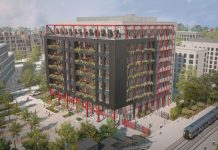Philip Morton of Morton Property Consultants reviews the Bristol office market:
The Bristol office market comprises approximately 14 million sq ft of stock, split between 3 main areas, namely City Centre, Clifton and Out of town. The overall sentiment of the market remains good, despite the economic uncertainty with an above average level of take up in 2017 and a significant number of deals under offer following a good start to the year. The level of supply is at its lowest for over ten years particularly of grade A.
City Centre Supply
The supply of office accommodation is at its lowest for the last 10 years at just 3.2%. The recent PDR regulations have allowed over 1.25 million sq ft of redundant, out dated offices to be converted into residential leaving a restricted supply for occupiers and a distinct shortage of grade A with no new existing space currently available. There is only one office, Aurora (95,000 sq ft), under construction that completes in June 2018 having successfully let three floors, with the remaining 41,000 sq ft under negotiation. This leaves a serious lack of new space in the market in the short to medium term.
The majority of the existing available accommodation is second-hand Grade B which totals circa 450,000 sq ft. There are significant refurbishments in the pipeline to include Resolutions Progamme, the first phase (45,000 sq ft ) reaches practical completion in April 18 and Temple Point 70,000 sq ft and 1 Redcliff Street (28,000 sq ft) completing in the summer 2018.
Consented schemes in the pipeline total circa 1.5 million sq ft, which are likely to go for commercial as the values of residential and offices are just about on par for the first time in recent years.
City Centre Demand
The Bristol city centre office market saw an above average take up of 614,028 sq ft, against the 2016 figure of 782,000 sq ft and is above the five year average of 565,000 sq ft. A good result in light of the uncertainty in the economy.
The number of enquiries remains constant and there is a general trend for companies to look for the highest quality of space available as they aim to recruit and retain top talent. There remains the large Government requirement for 200,000 sq ft, with four options shortlisted, which will influence what is built next on a speculative basis.
Grade A rents have smashed the £30 psf barrier with £32.50 psf being achieved at Aurora and second hand top rents being £31.00 – £32.50 psf achieved at One Cathedral Square, to the University of Bristol and Dyson.
Bristol has caught up other regional cities such as Birmingham, with Manchester being slightly ahead. With the supply being so low, 2018 maybe the year that Bristol leads the way.
Incentives have come down over the last few quarters with the average currently running at 1-1.5 months per year of term taken split equally around any break.
Lease terms remain determined by the size of the space taken, normally as follows:
5000 – 10,000 sq ft: 10 year lease, 5 year break
10,000 – 20,000 sq ft: 15 year lease, 10 year break
20,000 sq ft+: 15 years
Out of Town
The Out of town office market remains stable. 2017 saw a better than average take up at 425,292 sq ft against 308,374 sq ft in 2016 with the five year average being 338,205 sq ft.
Supply remains tight with no speculative offices under construction and rents being discounted from the city centre at £21.50 psf pa. Major refurbishments are underway, at 800 Aztec West and 600 Aztec West is likely to follow.
There remains an opportunity for north Bristol rents to catch up with the city centre as the 30% discount may tempt occupiers out of town to take advantage of the lower overall business costs.
Bristol and Bath Science Park was sold to South Gloucestershire during 2017 and there are some exciting developments within the park which will come on stream in mid to late 2018.
Keynsham’s Chocolate Factory has opened up a new market equidistant from Bristol and Bath, where huge success has been achieved in the mixed use development with over 60% let prior to practical completion which is due summer 2018.
The modern way of working
2017 has seen the continuing change in the way occupiers are looking to blend work and life together.
The concept of Core and Flex space is on the agenda and occupiers are keen to trade up to space that will attract the top talent, aid retention and be a place where staff want to go to work and offices that are the envy of their competitors.
This is not a trend, agile working increases margins and reduces costs by up to 20%, it is here to stay.



















